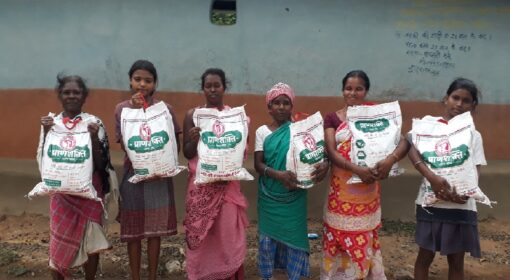by Irfan Ahmad

The community members of Kumharra Village, India, successfully established a ‘Comprehensive Homestead Model,’ which celebrates the concepts of sustainable ecological planning, regenerative approach, sustainable water management, and livelihood diversification. Under this model, multiple prototypes are complementary, promoting the sustainable development of homestead lands. The model focuses on maximizing the potential of homestead lands through implementing complementary prototypes. This model has been developed on the homestead plots of 28 Adivasi families in Kumharra, where the following prototypes have been established: 1) 10 decimal multilayered plot 2) Jal kund (small reservoir) with polythene lining 3) low-cost poultry shed 4) Compost pits 5) Intercropping of fruit plants with pulses:
- 10 decimal multilayered plots – The multilayered farming plot promotes efficient land use by incorporating different layers of crops, such as root vegetables, leafy vegetables, plant vegetables, and climbers. This maximizes productivity, enhances biodiversity, conserves soil moisture, and improves nutrient cycles. It provides a diverse range of produce and contributes to families’ food security and income generation. The total investment for this prototype is INR 10,000.
- Jal Kund (small reservoir) with polythene lining – Jal Kund facilitates rainwater harvesting, storage, and efficient water utilization. The stored water can be used for irrigation during dry periods, reducing dependence on external water sources and ensuring continuity in agricultural activities. This prototype was executed by leveraging labor payments from NREGS and financial support from the Green Transformation Pathways project by PRADAN, FES, MetaMeta, and Aidenvironment. The approximate cost of the polythene lining is INR 3000.
- Low-cost poultry shed – The establishment of these sheds enables the families to engage in a diversified livelihood activity, which contributes to income generation, provides nutritious food, and supports the recycling of organic waste through poultry manure.
- Compost pits – Compost pits ensure the production of nutrient-rich compost for agricultural purposes during the year. It supports the principles of regenerative agriculture and ensures sufficient availability of bio-inputs for the family.
- Intercropping of fruit plants with pulses – The model encourages intercropping fruit plants with seasonal pulses, such as pigeon peas and mustard, creating a synergistic relationship that promotes the growth and sustainability.


This model was demonstrated in one of the micro-irrigation sites under the TADP project. Farmers can now aim for higher returns from the same patch of land, which used to yield much lesser production quantities, following the regenerative agriculture approach, and securing safe consumption patterns. The Comprehensive Homestead Model is an example of integrated and sustainable land management, showcasing the potential for regenerative agriculture, water conservation, and livelihood improvement in an economically feasible manner. The success of this model can inspire and motivate other communities to adopt similar practices, leading to broader positive impacts in the region and beyond.



